Are you struggling with one or more area(s) of thick skin on your feet or toes?
Are you trying to figure out what is causing this annoying and sometimes painful condition to occur?
As a podiatrist, I can tell you that this is a VERY common ailment that I see routinely in my practice.
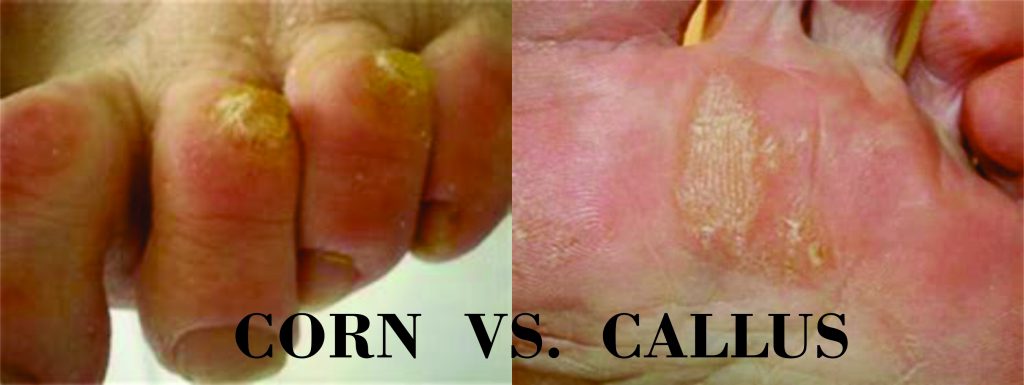
In this article, I would like to break down the difference of a corn vs. callus and give you a multitude of information on each so that we can have your feet both looking and feeling better in no time.
Here are the topics that I will be discussing. You can simply clink on the link to move directly to your area of interest.
- Corn vs. Callus – A Quick Overview
- Corn vs. Callus – Let’s Talk About Location
- Corn vs. Callus – The Differences in Appearance
- Corn vs. Callus – Which One Hurts Worse?
- Corn vs. Callus – Summary Chart
- Corn vs. Callus – Why Do They Form?
- What Causes a Corn vs. Callus?
- Corn vs. Callus – How Shoes Can Make an Impact
- Corn vs. Callus – Prevention & Treatment
All you have to do is read, so… sit back, put your reading glasses on and get ready to enjoy my post on “Corn vs. Callus – Everything You Need To Know”!
Corn vs. Callus – A Quick Overview
You hear people talking about corns and calluses all of the time (or at least I do anyways), so… what is the difference?
What is a corn vs. callus?
Let me begin by saying that corns and calluses are very similar as they are both areas of thick, dead skin caused by friction and/or pressure.
In addition, both a corn or a callus may or may not be painful.
The determinants between a corn vs. callus come down to simply the appearance and the location, or part of the body, where this friction or pressure has caused your (overly-annoying and often painful) thick skin to occur.

Both corns and calluses are more common in people who have sweaty feet, stand for long periods at a time and wear ill-fitting shoe gear.
Statistically, women are more affected with corns and calluses versus men.
Corn vs. Callus – Let’s Talk About Location
As stated above, you can quite simply determine if you are suffering from a corn vs. callus primarily by the area of the body that is affected.
A corn typically occurs solely on the toes.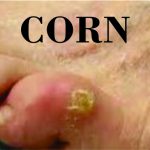
When a corn occurs within the webspaces (area of skin between the toes), we typically call the corn a soft corn. Corns located on the tops of your toes are usually referred to as a hard corn.
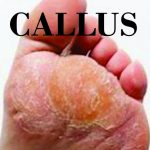 A callus, on the other hand, routinely surfaces on the hands or feet (excluding the toes).
A callus, on the other hand, routinely surfaces on the hands or feet (excluding the toes).
The most common locations for calluses to occur on the feet include the bottom of the heels and below the bony areas of the balls of the feet.
So… are there any other differences between a corn vs. callus other than simply location?
Corn vs. Callus – The Differences in Appearance
While corns and calluses, at first glance, usually seem to be very similar in appearance, if you look a little closer, you will see some very obvious differences in a corn vs. callus.
Both types of corns are typically smaller in size than calluses.
They are generally circular in shape and have a clearly defined center. Depending on the type of corn, this center can be hard or soft.
Soft corns (remember… these are corns located on the skin between the toes) usually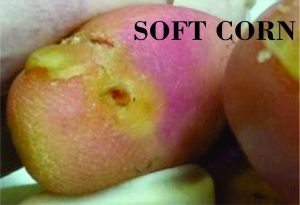 have the most distinct characteristics between the three.
have the most distinct characteristics between the three.
Soft corns, while still comprised of thick skin, typically have a more moist, whitish appearance to them.
Upon touch… they distinguish a soft, rubbery feel (hence the name “soft corn”).
Most of the time, these soft corns can mimic an open sore as the skin is built up around its edges and tends to “crater” in the middle of the lesion.
Hard corns, (located on the top of the toes) on the other hand, appear as a firm, thick build-up of dry, or dead, skin.
build-up of dry, or dead, skin.
These corns are usually small in size, round in shape and well-defined.
Usually, if you really inspect closely, you will see a ring within the hard corn.
The outside edges of this ring are typically soft and yellow, while the inside portion of the ring is very hard and gray.
It is typical to find inflamed, or red skin, surrounding the corn.
Calluses (located on the hands and anywhere else on the feet) give the impression of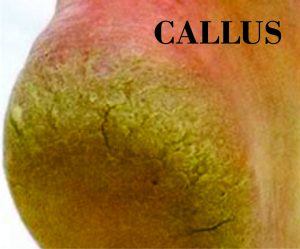 simply hard, dry and thick skin.
simply hard, dry and thick skin.
A callus can portray a mildly grayish, palish or yellowish color; but, this is not always the case.
Upon running your hand over a callus, you may feel a lumpy texture about the skin.
Larger in size (bigger and wider) than corns, calluses tend to vary in shape and its edges are ill-defined.
Corn vs. Callus – Which One Hurts Worse?
As stated above, both a corn and a callus may or may not be painful when pressure is applied to the lesion.
We do typically see, however, that pain is more common and usually more intense with a corn vs. callus.
corn vs. callus.
This pain, when present, also typically exhibits a different behavior in a corn vs. callus.
When a corn is palpated (or pressure is applied), if pain is present, the highest amount of pain is directly over the lesion… on top of the thick skin.
With a callus, on the other hand, pain is usually the greatest on palpation of the surrounding skin and less intense directly on top of the thick skin.
Corn vs. Callus – Summary Chart

Corn vs. Callus – Why Do They Form?
To begin, corns and calluses are not caused by a virus or bacteria and are NOT contagious.
So… how and why do we get them?
While the location and appearance of a corn vs. callus definitely reveal differences amongst the two, the causes of both corns and calluses are identical (with a small addition to the soft corn).
All corns and calluses, as briefly stated above, are caused by the culprit of repeated friction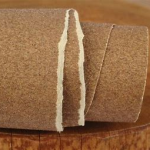 or pressure on a particular area of skin.
or pressure on a particular area of skin.
This pressure (and/or friction) results in direct damage to the skin that it is imposed on.
Our bodies react to this imposition and respond to the damage.
Essentially, in its attempt to address and repair the damage, it protectively creates a hard surface over the area which we term a corn or callus.
Because soft corns are located between the toes and this area of our feet typically stays more moist due to trapped sweat, we typically see a softening of the once hard core in soft corns.
What Causes A Corn vs. Callus?
Anything that can cause friction or pressure to your skin can cause both a corn or callus.
Typically, calluses on the hands are caused from pressure by any repetitive handling of a tool or object.
tool or object.
Some examples of these can include a gardening hoe, hammer, tennis racket and lifting weights.
Some causes of corns and calluses on the feet can include the following:
- Footwear
- Shoes that are too tight and cause pressure
- Shoes that are too high-heeled and cause pressure on the sole of the foot
- Shoes that are too loose and cause friction
- An exaggerated seam within a shoe that causes friction
- Socks that do not fit well or the absence of socks
- Walking barefoot regularly as the skin will naturally thicken to protect itself
- Foot deformities – bunions, hammertoes, claw toes, mallet toes, bumps caused by Rheumatoid Arthritis
- Repeated actions – pressure due to sports, jogging or walking
- Abnormal gait (odd way of walking)
- Bone structure – flat feet or bone spurs
- Advanced age – less padding on the balls of the feet
Corns vs. Callus – How Shoes Can Make An Impact?
While some causes of corns and calluses are unpreventable, there are some things that we CAN do to minimize our risks of developing these annoying conditions… especially when it comes to shoes!
I have summarized several ways to eliminate the risk of corns and calluses directly due to shoe gear below!
Only buy properly fitting shoes.
When making a shoe purchase at your preferred shoe store, it is essential to have BOTH feet professionally measured in BOTH length and width in order to ensure the proper size selection.
feet professionally measured in BOTH length and width in order to ensure the proper size selection.
ALWAYS try BOTH shoes on and walk around the store!
You should ensure that the end of the shoe is no closer than a half of an inch to your longest toe.
Can you wiggle your toes? If not… the shoe is simply too tight.
Shop for new shoes at the end of the day.
Why you ask?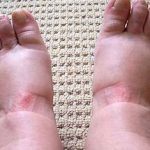
Our feet naturally swell throughout the day.
To avoid the issue of your shoes becoming too tight in the evenings, you want to ensure that you purchase shoes that will accommodate for this.
Be smart with your shoe style.
Avoid shoes with extremely high heels and sharply pointed toes.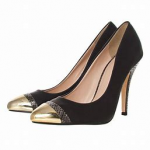
Wear as low of a heel as possible!
If you MUST wear this style of shoe for work… minimize the damage by investing in a nice pair of athletic shoes to wear to and from work (and on your lunch break) to give your feet a break from all of the added pressure points that heels cause.
Also, if you have structural foot deformities, make sure that you will select a style of shoe that will accommodate for this.
For example, if you have hammertoes (a condition in which the toes buckle up), make sure that the shoe that you select either has a toe box with extra depth to it OR a toe box that is constructed of flexible material that will move with your deformity.
Watch the “wear” pattern on the soles of your shoes.
As you put the miles on your shoes, eventually the internal lining and soles can wear down.
When this occurs, the ability for our shoes to act as a shock absorber for the hard surfaces that we walk on is substantially decreased.
To avoid this, have the soles of your shoes replaced regularly or simply realize that it is time to invest in a new pair.
Also, you want to check for even “wear” on the soles and heels of your shoe.
Uneven “wear” patterns could signal that you have an abnormal gait cycle that is causing an increased pressure point to a particular area of your foot.
This can easily be fixed with the purchase of personalized, corrective insoles.
Corn vs. Callus – Other Simple Preventative Measures
Wouldn’t it be great if we could prevent corns and calluses from showing up in the first place?
You already know how to ensure that inadequate shoe gear doesn’t contribute to the formation of these annoying ailments, but what else can you do to be pro-active?
The following are simple recommendations to decrease the likelihood that you will develop both corns and calluses:
- Wash your feet every day. Use water, soap and a scrubbing brush. Following… ensure to dry your feet thoroughly.
- Do NOT use body lotion on your feet. Instead,… invest in a moisturizing foot cream made especially for the feet.
- Remove hard skin gently and regularly. This is best performed with a foot file or pumice stone.
- Wear padded gloves or utilize tools with padding in order to protect your hands when handling tools.
- Wear comfortable socks in order to reduce friction to your feet caused by some shoe gear.
- If foot deformities are present, invest in pads and cushions to reduce pressure points and friction. I have listed some of my favorites below.
Corn vs. Callus – Final Words
As you can see, there are both many similarities and differences between a corn vs. callus.
Neither of these two foot ailments are fun to deal with and pain can occur.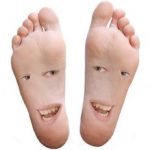
Whether a corn vs. callus, there ARE things that you can do to lessen the likelihood of you having to suffer from the annoying problems that having either of these can cause.
Be proactive and take the steps necessary to ensure that your risk of developing a corn and/or callus is minimized.
I hope you enjoyed this article on a corn vs. callus. As always, I welcome any feedback, comments or questions below. I am truly here to help!
Sincerely,
Dr. Misty
Podiatric Physician and Owner of FixUglyNails.com.
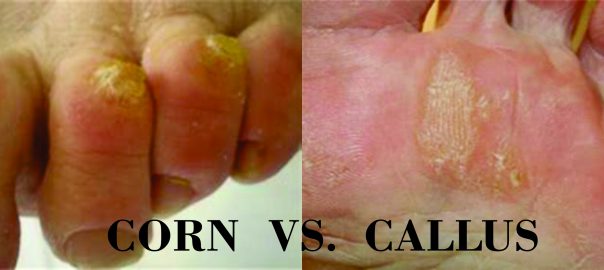
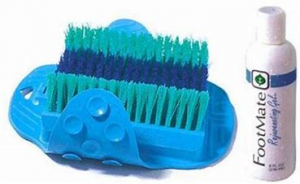
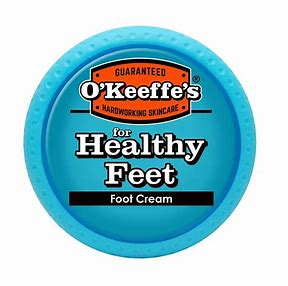

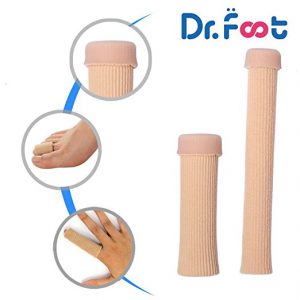
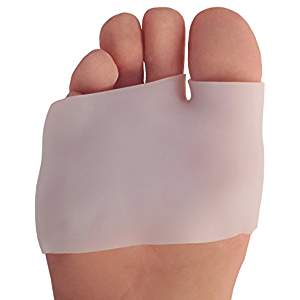
I am so glad that I found this post. I have always wondered the difference in a corn vs. callus. This was totally useful. My son is currently dealing with ‘sometihng’ on his toes and I was confused. After reading your article I am pretty sure that I know exactly what is going on and how to help him. Thanks.
Hello Tamarra! I am glad that you found my post “Corn vs. Callus – Everything You Need To Know” as well. As mentioned, I would begin by gently filing the lesion down and then applying padding to the area. The Dr. Foot’s Toe Tubes are absolutely amazing and are my go-to product to pad the areas of the toes! ((:
So glad I could help! Should you have any additional questions or concerns please feel free to comment below! I am truly here to help!
HI Dr. Misty,
I have been suffering for years with corns on both my little toes after wearing tight shoes, I want to get rid of them is it possible?
Thanks
Hello Charlie! Thanks for visiting my post titled “Corn vs. Callus – Everything You Need to Know”. More than likely your “little toes” have what we call an adductovarus rotation. In other words, they kind of bend. We typically see corns on the 5th toe when this deformity is present. So… the best way to cure the corn is to fix the deformity! Most people believe that this can only be achieved via surgery, but this is absolutely not the case. If you click HERE, you will be redirected to my post addressing this issue and exactly how you can fix foot deformities with a small, safe, cheap product!
Should you have any additional questions or concerns please feel free to comment! I am truly here to help! Also… please come back and give us your review of this amazing product once you decide to try it out! Believe me… you will NOT be disappointed in your results! Thank you and have a great evening! ((:
You have done a very thorough job of explaining these foot problems. They say you learn something new everyday and I didn’t realize socks that do not fit well or the absence of socks could cause problems as well. After you explained how corns and calluses are formed, that makes total sense.
I, personally, have heard of ladies that wear high heels having problems. I know women who wear heels and when asked, their feet actually hurt, but they choose appearance over pain. I don’t know how people do that, but painful feet have never been a friend of mine.
Thank you so much for sharing all this information. Your site is very informative and I look forward to coming back to read more information. What are some other common foot problems you will share with us?
Have a wonderful rest of the week.
Kind Regards,
Yvette
Hi Yvette and thank you for visiting my site! I am definitely here to bring awareness to common foot conditions that people struggle with on a daily basis. Most of these conditions have simple resolutions that some doctors are frankly scared to recommend because it may take away from their visits/income. I see women having multiple foot problems on a regular basis due to the regular use of heels! There are products to resolve this without having to give up those cute shoes! More on this to come. In addition, I will soon be posting some articles on diabetes and foot pain! Lots more good stuff to come! I truly am here to help!
This is really useful information: I hadn’t realized most of what is in this post, I’d heard the terms “corn” and “callus” and thought they were interchangeable – now I know better! If, despite your tips on how to prevent them, one of these forms, what’s the best way to get rid of them? Are there any home treatments or does it need a trip to the chiropodist?
Hello drinkteahub. I am so glad that you found my article useful. now onto your question… Should a corn or callous develop, it is best to gently file it down to the level that healthy skin is present. One of the easiest ways to do this is via an electric foot file which is gentle but gets the job done. Following removal of the corn or callus, it is essential to prevent its return, which will happen unless you put preventative measures into place. I hope this helped! Let me know if you have any additional questions!
This Is the first time I’m reading about the difference between Corn and callus, I’m very found of mixing it up but this post has really enlightened me and now I can tell the difference between both. Please, why is it that sometimes Callus and corn don’t pain AMD sometimes they become so severely painful? I really enjoyed reading through this article, I’ve been really educated. Thank you.
Good morning Jones and I am thrilled that I could help you understand the difference between a corn vs. callus. To answer your question… sometimes in the very early stages of their development, corns and calluses can be pain-free. But… it is only a matter of time until they build up enough to cause pressure to the nerves directly under the skin and cause pain. Please let me know if you have any additional questions! I am truly here to help!
This is a really helpful article that has clearly addressed this common problem of the feet.. before I read this post I was wondering the difference between a Corn/Callus! I have personally learned a lot trough your article. I appreciate it.
you have placed some stuff among your post that would be nice to help this Skin disease.I would like to purchase the O’Keeffe’s for Healthy Feet Foot Cream, 3.2 Ounce. Since it seems that this cream is doing a pretty god job for skin and makes It soften and neat.
I have bookmarked your page and will share with anyone who is suffering from this condition. Thanks
Good evening Shirian! I am happy that you found my article educational. Warning… once you try the O’Keeffe’s for Healthy Feet Foot Cream, you will NEVER go back to anything else… IT REALLY IS THAT GOOD!!! Just let me know if you ever have any questions… I want to help people. That is why I am here. Also, feel free to come back and give my readers and I a review of the product. You will absolutely LOVE it!